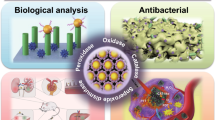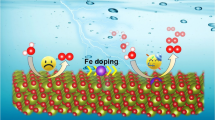Abstract
Cobalt oxide (Co3O4) has attracted considerable interest because of its high catalytic activity, especially for intrinsic catalase (CAT)-mimic and superoxide dismutation (SOD)-mimic activities. However, understanding of its catalytic mechanism from atomic or molecular level remains limited. Here, we propose base-like dissociative, acid-like dissociative and bi-hydrogen peroxide associative mechanisms of CAT-mimic activity, Langmuir–Hinshelwood (LH) and Eley–Rideal (ER) mechanisms of SOD-mimic activity on cobalt oxide surface with atomistic thermodynamic and kinetic details by a combination of rigorous density functional theory and microkinetic modeling. The catalytic activity of Co3O4 depends strongly on their size and structure. In this study, Co3O4 nanozyme with different size and structure exhibited different catalytic activities in the order of (Co3O4)2 > (Co3O4)3 > Co3O4. This order is closely related to their weak, tunable Co–O bonds. Our microkinetic modeling analysis shows that bi-hydrogen peroxide associative mechanisms (mechanism C) of CAT-mimic activity and ER mechanism of SOD-mimic activity for (Co3O4)2 are favorable, which is identified by the rate-determining steps (RDS), Energy span model (ESM), and microkinetic modeling analysis. For the CAT-mimic activities on (Co3O4)n surface, Campbell’s degree of rate control analysis indicates the key to catalyst improvement and design is to stabilize the key steps, which are related to the formation of H2O molecular. For the SOD-mimic activities of (Co3O4)n, we find the formation of H2O2 molecular to be the sole rate-controlling step. Degree of the thermodynamic rate control analysis reveals that the stronger H2O2*, OH* binding would facilitate the reaction of CAT-like activities of (Co3O4)n. And the adsorbed OHOO* with large negative degree of thermodynamic rate control would inhibit the reaction of CAT-like activities of (Co3O4)n. Our results have not only provided new insights into deciphering (Co3O4)n artificial enzymes, but will also facilitate the design and construction of other types of target-specific artificial enzymes.





Similar content being viewed by others
References
Singh R, Singh S (2019) Colloids Surf B 175:625–635
Bhagat S, Srikanth Vallabani NV, Shutthanandan V, Bowden M, Karakoti AS, Singh S (2018) J Colloid Interface Sci 513:831–842
Singh S (2019) Front Chem 7:46
Halliwell B, Gutteridge JMC (1990) Method Enzymol 186:1–85
Giorgio M, Trinei M, Migliaccio E, Pelicci PG (2007) Nat Rev Mol Cell Bio 8:722–728
Brioukhanov A, Netrusov A (2004) Biochemistry (Moscow) 69:949–962
Su H, Liu DD, Zhao M, Hu WL, Xue SS, Cao Q, Le XY, Ji LN, Mao ZW (2015) ACS Appl Mater Interfaces 7:8233–8242
Valko M, Leibfritz D, Moncol J, Cronin MT, Mazur M, Telser J (2007) Int J Biochem Cell Biol 39:44–84
Poizot P, Laruelle S, Grugeon S, Dupont L, Tarascon JM (2000) Nature 407:496–499
Hutchins MG, Wright PJ, Grebenik PD (1987) Sol Energy Mater 16:113–116
Li WY, Xu LN, Chen J (2005) Adv Funct Mater 15:851–857
Maruyama T, Arai S (1996) J Electrochem Soc 143:1383–1388
Jiang DE, Dai S (2011) Phys Chem Chem Phys 13:978–984
Tao FF, Shan JJ, Nguyen L, Wang Z, Zhang S, Zhang L, Wu Z, Huang W, Zeng S, Hu P (2015) Nat Commun 6:7798
Tyo EC, Yin C, Di Vece M, Qian Q, Kwon G, Lee S, Lee B, DeBartolo JE, Seifert S, Winans RE, Si R, Ricks B, Goergen S, Rutter M, Zugic B, Flytzani-Stephanopoulos M, Wang ZW, Palmer RE, Neurock M, Vajda S (2012) ACS Catal 2:2409–2423
Fung V, Tao F, Jiang D (2016) Catal Sci Technol 6:6861–6869
Zhang S, Shan JJ, Zhu Y, Frenkel AI, Patlolla A, Huang W, Yoon SJ, Wang L, Yoshida H, Takeda S, Tao F (2013) J Am Chem Soc 135:8283–8293
Xie XW, Li Y, Liu ZQ, Haruta M, Shen WJ (2009) Nature 458:746–749
Mu J, Wang Y, Zhao M, Zhang L (2012) Chem Commun 48:2540–2542
Gao L, Zhuang J, Nie L, Zhang J, Zhang Y, Gu N, Wang T, Feng J, Yang D, Perrett S, Yan X (2007) Nat Nanotechnol 2:577–583
Mu J, Li J, Zhao X, Yang E, Zhao X (2018) Sens Actuators B 258:32–41
Yin J, Cao H, Lu Y (2012) J Mater Chem 22:527–534
Mu J, Zhang L, Zhao M, Wang Y (2014) ACS Appl Mater Interfaces 6:7090–7099
Mu J, Zhang L, Zhao M, Wang Y (2014) Phys Chem Chem Phys 16:15709–15716
Perdew JP, Burke K, Ernzerhof M (1996) Phys Rev Lett 77:3865–3868
Frisch MJ, Trucks GW, Schlegel HB, Scuseria GE, Robb MA, Cheeseman JR, Scalmani G, Barone V, Mennucci B, Petersson GA (2009) Gaussian 09, Revision A.1, Gaussian, Wallingford, CT
Jirkovsky JS, Busch M, Ahlberg E, Panas I, Krtil P (2011) J Am Chem Soc 133:5882–5892
Liu X, Prewitt CT (1990) Phys Chem Miner 17:168–172
Selcuk S, Selloni A (2015) J Phys Chem C 119:9973–9979
Lide DR (2003) Handbook of chemistry and physics. CRC Press, Boca Raton
Piskorz W, Zasada F, Stelmachowski P, Kotarba A, Sojka Z (2008) Catal Today 137:418–422
Shojaee K, Montoya A, Haynes BS (2013) Comput Mater Sci 72:15–25
Guo R, Wang H, Peng C, Shen M, Pan M, Cao X, Zhang G, Shi X (2010) J Phys Chem C 114:50–56
Amatore C, Jutand A (1999) J Organomet Chem 576:254–278
Kozuch S, Shaik S (2006) J Am Chem Soc 128:3355–3365
Ma L, Melander M, Weckman T, Laasonen K, Akola J (2016) J Phys Chem C 120:26747–26758
Wynne-Jones WFK, Eyring H (1935) J Chem Phys 3:492–502
Slesak I, Lesak HS, Zimak-Piekarczyk P, Rozp-ądek P (2016) Astrobiology 16:348–352
Zhang W, Hu S, Yin JJ, He W, Lu W, Ma M, Gu N, Zhang Y (2016) J Am Chem Soc 138:5860–5865
Huber KP, Herzberg G (1979) Molecular spectra and molecular structure. Van Nostrand Reinhold, New York
Wang W, Wang Y, Wang G (2018) Phys Chem Chem Phys 20:2492–2507
Kozuch S, Shaik S (2011) Acc Chem Res 44:101–110
Mishra PC, Singh AK, Suhai S (2005) Int J Quantum Chem 102:282–301
Haraguchi H, Ishikawa H, Mizutani K, Tamura Y, Kinoshita T (1998) Med Chem 6:339–347
Lin WS, Armstrong DA, Lal M (1978) Int J Radiat Bio 33:231–243
Bielski BHJ, Cabelli DE, Arudi RL, Ross AB (1985) J Phys Chem Ref Data 14:1041
Weinberg WH (1996) Acc Chem Res 29:479–487
Campbell CT (2017) ACS Catal 7:2770–2779
Stegelmann C, Andreasen A, Campbell CT (2009) J Am Chem Soc 131:8077–8082
Acknowledgements
This work was financially supported by the “1331” project of Shanxi Province, High School 131 Leading Talent Project of Shanxi, the Natural Science Foundation of Shanxi, and Undergraduate Training Programs for Innovation and Entrepreneurship of Shanxi Province, Graduate student Innovation Project of Shanxi Normal University, Shanxi Graduate Education Innovation Project.
Author information
Authors and Affiliations
Corresponding author
Additional information
Publisher's Note
Springer Nature remains neutral with regard to jurisdictional claims in published maps and institutional affiliations.
Electronic supplementary material
Below is the link to the electronic supplementary material.
Rights and permissions
About this article
Cite this article
Guo, S., Han, Y. & Guo, L. Mechanistic Study of Catalase- and Superoxide Dismutation-Mimic Activities of Cobalt Oxide Nanozyme from First-Principles Microkinetic Modeling. Catal Surv Asia 24, 70–85 (2020). https://doi.org/10.1007/s10563-019-09290-4
Published:
Issue Date:
DOI: https://doi.org/10.1007/s10563-019-09290-4




